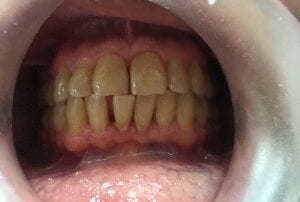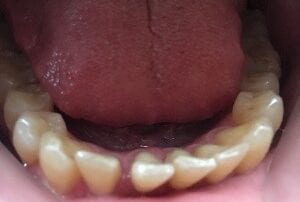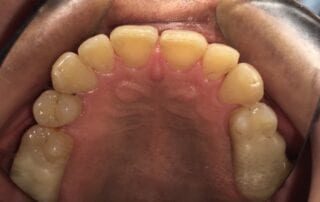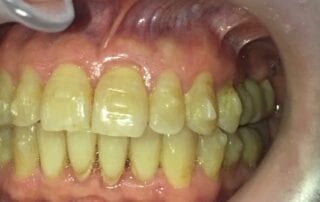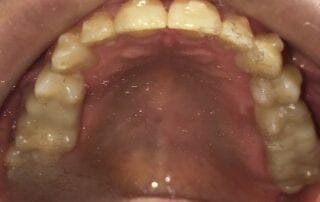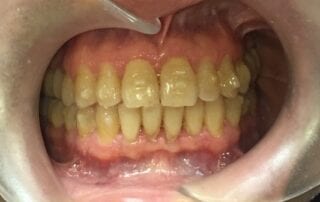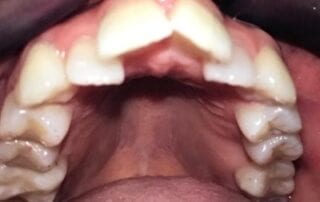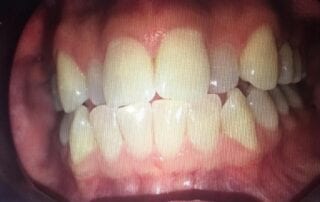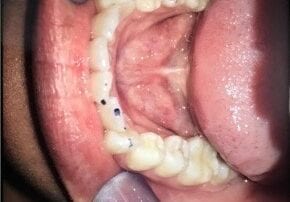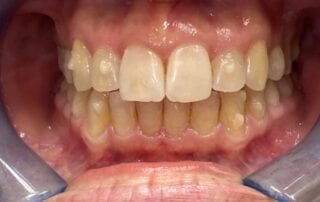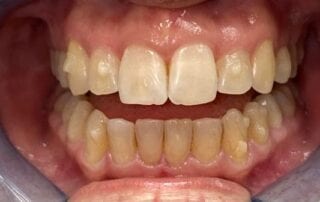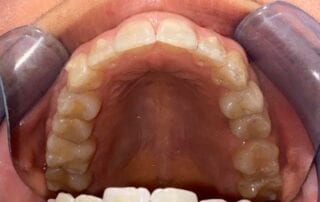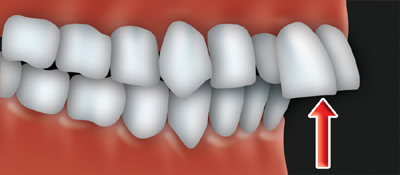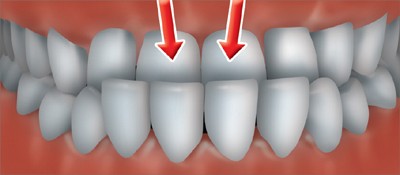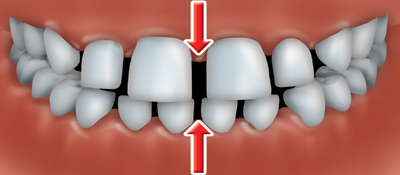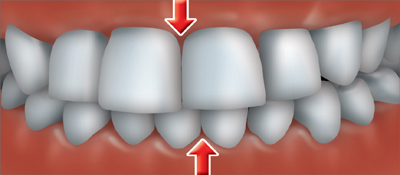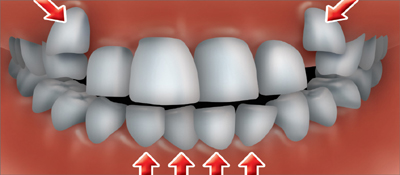Invisalign and Orthodontics in Oakville, ON
Orthodontics near me is a specialized field of dentistry focused on diagnosing, preventing, and treating dental and facial irregularities. The main goal of orthodontics Oakville is to correct malocclusion, which happens when a person’s teeth are crowded.
Orthodontists often use Invisalign in orthodontic treatments. Invisalign is the brand name of a type of clear aligner used in orthodontics as an alternative to traditional metal braces. Invisalign aligners are custom-made using advanced 3D computer imaging technology to gradually move teeth into the desired position. They are transparent, removable, and made from a flexible thermoplastic material called SmartTrack.
Invisalign aligners are clear and nearly invisible when worn. They are custom-made and do not cause irritation. You can remove your Invisalign aligners before eating, brushing, and flossing.
Invisalign Cases – Before and After
When is Invisalign Used?
An orthodontist may use Invisalign near me to treat the following dental conditions
- Crowded Teeth: If there isn’t enough space in your jaw for all of your teeth to fit, they can overlap, which results in dental crowding. Invisalign aligners can gradually move your teeth into their ideal position
- Overbite: The dental problem occurs when the upper teeth bite over the lower teeth. It can cause gum problems or irritation and/or premature wear and tear. Overbite can also cause jaw pain.
- Underbite: If your lower teeth protrude beyond your upper front teeth, an underbite can occur. Underbites can cause difficulty chewing and speaking, and wear and tear on the front teeth
- Crossbite: A crossbite occurs when two or more of your upper teeth close inside the lower teeth rather than on the outside. It can increase wear and tear on your teeth, causing gum disease, and bone loss
- Gaps Between Teeth: Or Diastema can occur naturally. The problem can also be caused by missing teeth. Orthodontists use Invisalign in Oakville to close gaps between their patients’ teeth to improve their appearance and reduce their risk of gum problems
- Open Bite: An open bite is a type of malocclusion. It occurs when some of your teeth cannot make contact with the opposing teeth. It can be corrected with Invisalign
The position of your teeth and jaws has an effect on your bite. Your bite is how your top and bottom teeth come together. When your top and bottom teeth do not fit together properly, this is called a malocclusion or a bad bite. Problems like missing, crooked, crowded or protruding teeth can contribute to a bad bite. Thumb or finger sucking may also affect your bite.
A bad bite can make it hard to chew some foods and may cause some teeth to wear down. It can also cause muscle tension and pain. Teeth that stick out are more easily chipped or broken. Crowded and crooked teeth are harder to clean and may be more likely to get cavities and gum disease. Fixing a bad bite improves your smile and your health. Different types of bad bites include an overbite, a crossbite, an overjet and an open bite.
An overjet occurs when the upper front teeth protrude.
A deep bite occurs when the upper front teeth cover the lower front teeth too much.
A crossbite occurs when the upper teeth fit inside the arch of the lower teeth.
An open bite occurs when the back teeth are together and there is an opening
between the lower and upper front teeth.
Gaps between teeth
A midline discrepancy occurs when one or more of your upper teeth don’t
line up with the appropriate lower tooth or teeth .
Crowded or overlapped teeth
Who does this procedure?
Your dentist may do basic orthodontic treatment or refer you to an orthodontist. An orthodontist is a dentist who has completed a university post-graduate specialty program in orthodontics. Orthodontics in Oakville is a specialty of dentistry that deals with preventing and correcting malocclusions.
Who can get orthodontic treatment?
Orthodontic treatment isn’t just for teens, as teeth can be moved at any age. In fact, more and more adults are having orthodontic treatment to improve the look and health of their smile. Your dentist or orthodontist can evaluate if orthodontic treatment is right for you.
In some cases it is helpful to start orthodontic treatment before all the permanent (adult) teeth come in. This is called interceptive orthodontics. Your dentist or orthodontist can do an orthodontic screening to find out if your child will need orthodontic treatment to correct a bad bite. Interceptive orthodontics allows your dentist or orthodontist to treat or stop a problem as it is developing.
How long does treatment take?
Orthodontic treatment takes time. The amount of time depends on your age, the seriousness of your problem and the treatment technique used. Treatment generally involves a visit to your dentist or orthodontist on a regular basis over a period of months to years. In general, it takes longer to treat adults than children or teenagers. Most people wear braces for about 2 years.
Orthodontic treatments
Depending on the extent of your bad bite, your dentist or orthodontist in Oakville may suggest one or a combination of the following orthodontic treatments to correct your bite:
- Braces.
- Headgear.
- Removable appliances.
- Retainers.
- Oral surgery.
Other Common Types of Orthodontic Treatments
Orthodontists also use braces, retainers, palatal expanders, and headgear to address common dental problems such as crooked teeth, overbites, underbites, crossbites, and spacing issues.
- Braces: Consist of brackets, bands, and wires designed to bring misaligned teeth back into alignment and fix bite problems. They are made of metal, ceramic, or plastic
- Retainers: Are often used to keep teeth in their new, correct position after braces are removed. Retainers can be permanent or removable
- Palatal expanders: Your dentist may use palatal expanders to widen your upper jaw, ensuring your upper and lower teeth fit together better
- Headgear: Is used to correct overbites and underbites. Consisting of a facebow, and extraoral anchorage, it moves the front teeth and jaw closer to the lower teeth
Braces
The most common type of orthodontic treatment used by dentists or orthodontists is braces.
How braces are done
To apply braces, your dentist or orthodontist attaches brackets (or bands) to each tooth with glue. Arch wires are fitted into all the brackets and are usually held in place with rubber or wire ties.
You may feel some discomfort for a while when your braces are first put on and when they are adjusted. It will take a little time to get used to your braces and they can bother your lips and cheeks. If this happens, a relief wax can be applied to your braces. To make eating easier after an adjustment, soft foods are recommended.
Caring for your teeth with braces
Proper brushing and flossing is even more important for people with braces because plaque can easily build up around the edges of your braces. If this plaque is not properly removed, white or brown marks may appear on the enamel surface of your teeth and these marks may be permanent.
Brushing and flossing with braces take longer. It is important to brush your braces as well as the front, back and chewing surfaces of the teeth. Your dentist or orthodontist will give you tips on how to brush and on how to floss using floss threaders. Parents should supervise their children to make sure they do a good job cleaning their teeth and braces and follow the advice of their dentist or orthodontist.
Caring for your braces
If you have braces, do not bite on hard things such as ice cubes and nuts. Do not chew the ends of pens or pencils. Also avoid sticky treats like chewing gum or toffee because they can loosen braces, distort wires and even pull braces off your teeth. If any of these problems happen, you will need to have your braces repaired by your dentist or orthodontist.
If the elastics or ties come off the bracket, you may be able to put them back around the bracket using small tweezers. If a wire is sticking out and bothering your lip or cheek, you may be able to push it back into place with the rubber eraser end of a pencil or it may be carefully cut off with a nail clipper. When a problem happens, always contact your dentist or orthodontist to have your braces checked as soon as possible. Problems that are not fixed can cause the treatment to last longer.
Choices in braces
Today’s braces are smaller and less noticeable. Besides the traditional metal braces, there are tooth-coloured ceramic braces that are less noticeable. Clear aligners are also available for adults and teenagers. Braces and elastics can also be multicoloured. Speak to your dentist or orthodontist about all your choices.
Headgear
This treatment uses an appliance that fits around the head or neck. It guides the direction of tooth movement and jaw growth in someone who is still growing. There are different types of headgear and they may be worn during any part of the orthodontic treatment. Your orthodontist or dentist will show you how to put on the headgear and tell you how long to wear it each day. In most cases it is worn during the evening and at night.
Removable appliances
Although removable appliances are not as precise as braces, they can move a tooth or a group of teeth. They are fitted by your dentist or orthodontist. Removable appliances can be worn before braces are applied, while braces are worn, or on their own to treat specific problems.
Retainers
Once your braces have been removed, a retainer can be used to keep your teeth in the right place. Retainers are fixed (attached to the teeth) or removable. They may need to be worn all the time or part of the time.
Oral surgery
Tooth removal may be needed if your teeth are crowded or if a tooth is badly out of position. Jaw surgery (or orthognathic surgery) may be needed when there are major differences in the size or position of the upper and lower jaws. If your orthodontist thinks you will need jaw surgery, he or she will refer you to an oral and maxillofacial surgeon.
Why Choose White Lily Dental Centre to Perform an Orthodontic Procedure?
White Lily Dental Clinic is a reputable dental practice in Oakville, ON. Our orthodontists leverage their expertise to plan and perform orthodontic treatments flawlessly. We are committed to transforming the lives of people trying to cope with orthodontic problems with personalized braces, retainers, and Invisalign.
Our orthodontists have years of experience of performing orthodontic procedures. They understand orthodontics principles and follow best practices for planning and performing orthodontic procedures. Our professionals plan every treatment down to the last detail. Effective planning prevents complications and helps achieve desired results.
We use state-of-the-art equipment to perform orthodontic procedures. Our advanced tools help our orthodontists avoid mistakes, improving patient outcomes. Unclean orthodontic equipment can lead to an infection and cause complications. After a procedure is performed, we thoroughly sanitize the orthodontic equipment that was used in it.
After performing orthodontic procedures, our orthodontists share tips with their patients that they can follow to keep their braces or clear aligners in good working order, prevent problems that can affect the efficacy of these devices and increase their lifespan.
To consult an orthodontist, call our office.
FAQs
Invisalign is a popular orthodontic treatment option that uses clear, removable aligners to gradually straighten teeth. The aligners are custom-made for each patient and are designed to be nearly invisible when worn. They apply gentle pressure to gradually shift the teeth into the desired position. Treatment with Invisalign involves a series of aligners, each worn for about two weeks until the desired results are achieved.
The duration of the Invisalign treatment process in Oakville can vary depending on the complexity of the orthodontic issues and the individual’s specific treatment plan. On average, treatment with Invisalign can take anywhere from several months to over a year. Your dental professional will provide a more accurate estimate of the treatment duration based on your specific needs.
For optimal results, it is generally recommended to wear the Invisalign aligners for 20 to 22 hours per day. The aligners should be removed only for eating, drinking (except for plain water), brushing, and flossing. Consistency in wearing the aligners as directed by your dental professional is essential to ensure the effectiveness of the treatment.
To clean and maintain your Invisalign aligners in Oakville, it is recommended to gently brush them with a toothbrush and mild toothpaste or use the Invisalign cleaning system provided by your dental professional. Avoid using hot water or abrasive cleaners, as they can damage the aligners. Additionally, make sure to keep the aligners in a clean and secure case when not in use.
Orthodontics is a branch of dentistry that focuses on correcting misaligned teeth and jaws. Orthodontic services in Oakville typically include a range of treatments designed to straighten teeth, improve bite alignment, and enhance overall oral health. This can include traditional metal braces, ceramic braces, Invisalign aligners, retainers, and other orthodontic appliances.
Orthodontic treatment in Oakville offers several benefits, including improved oral health, enhanced aesthetics and self-confidence, better bite alignment, reduced risk of dental issues such as tooth decay and gum disease, and improved overall functionality and comfort while chewing and speaking. Orthodontic treatment can also help prevent or address issues such as overcrowded teeth, gaps, and misaligned jaws.
Orthodontic treatment in Oakville may involve various types of appliances depending on the specific needs of the patient. This can include traditional metal braces, which use metal brackets and wires, ceramic braces that are less visible due to tooth-colored or clear materials, lingual braces that are placed on the back of the teeth, and clear aligners like Invisalign. The choice of the appliance depends on factors such as the severity of the orthodontic issues, treatment goals, and personal preferences.


